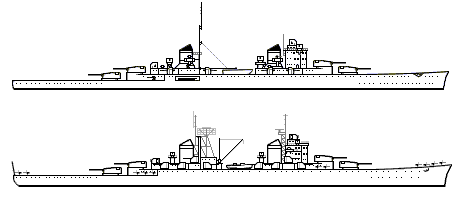You are not logged in.
Dear visitor, welcome to WesWorld. If this is your first visit here, please read the Help. It explains in detail how this page works. To use all features of this page, you should consider registering. Please use the registration form, to register here or read more information about the registration process. If you are already registered, please login here.


Quoted
Originally posted by Red Admiral
This is with SS3b2 which is identical to SS2 besides the report format.
Quoted
And there is just one thing I wonder about : Are those small guns on the bow and stern? If so, I wonder if they are well placed. At the extreme bows the vertical motion of the ship is the highest and could make accurate AA fire impossible - besides spray or overcoming water on the bow.
Quoted
Originally posted by Red Admiral
Differences are in armament only. Fewer shells are carried for secondary weapons which reduces mass. Additionally the armament mass calculation was re-worked in SS3b2 to take into account weapon length and more mounting details. Overall the effect is negligible, and SS3b2 is more pessimistic.
Quoted
SSv2.1 is the version to be used for any official design on WesWorld. No other SS version is accepted.
So no SS3 - regardless of version and what people say.
Quoted
Originally posted by Brockpaine
SSv2.1 is the version to be used for any official design on WesWorld. No other SS version is accepted.
So no SS3 - regardless of version and what people say.
Quoted
Differing number of shells per gun for the secondaries could contribute to part of that, but not .19 composite IMO

Quoted
Originally posted by Red Admiral
Quoted
Originally posted by Brockpaine
SSv2.1 is the version to be used for any official design on WesWorld. No other SS version is accepted.
So no SS3 - regardless of version and what people say.
That's fair enough with SSb3 which has significant differences, especially with regards to propulsion (a new drag model IIRC). However, SS3b2 is essentially the same as SS2.1 underneath; it just allows for additional detail with regards to things like number of shells for secondary armament, improved layout options. Important to note that SS3b2 is not more optimistic.
Forum Software: Burning Board® Lite 2.1.2 pl 1, developed by WoltLab® GmbH
